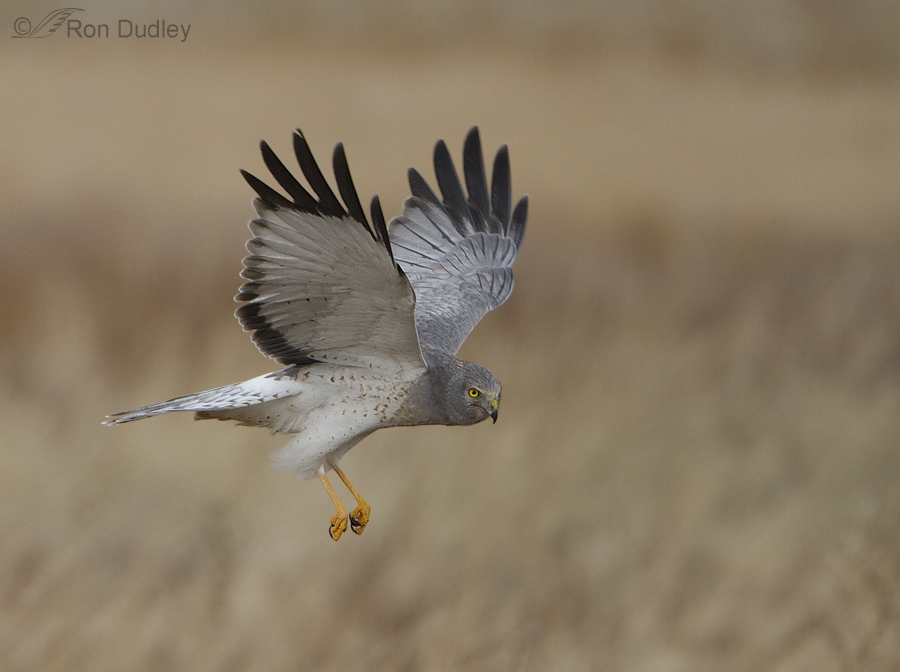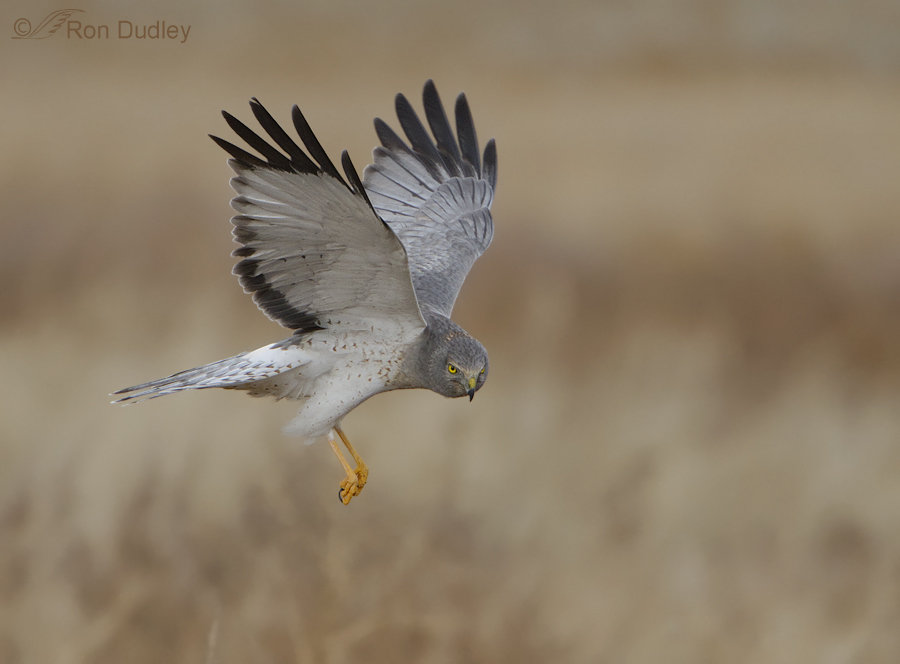I’ve been photographing Northern Harriers for almost 7 years now and I still get a thrill whenever I can get close to one of these shy hawks. And if it’s an elusive adult male (the “Gray Ghost”), well that’s just icing on the cake.
1/1250, f/5.6, ISO 800, 500 f/4, 1.4 tc, not baited, set up or called in
This one was using the “low and slow” hunting technique that I described in an earlier post. Notice the hanging feet that are often indicative of this type of hunting. In my experience they don’t do this very often when they’re this close to humans because their air speed is so slow that (I suspect) it makes them feel quite vulnerable – any evasive maneuver to avoid potential danger from someone like me would be more difficult to pull off at that very slow speed.
Most of the time this bird was looking down as it hunted but occasionally he would glance in my direction just to check me out – which allowed me to get momentary eye contact.
1/1250, f/5.6, ISO 800, 500 f/4, 1.4 tc, not baited, set up or called in
I was able to get two almost identical images of him – one wing beat and two shutter clicks apart. The primary difference between the two shots is the angle of the head.
It’s interesting to note that males tend to hunt in more open habitat than females do – the significantly larger females prefer denser and taller vegetation. This is partly because males take more birds as prey than females do but also because females exclude males from their preferred hunting habitats during winter.
I’ve noticed the results of those preferences in my images. Most of my photos of hunting harriers show the males in open areas as you see here while the shots of females tend to show them hunting tall and dense stands of phragmites.
Ron




Wonderful series of that magnificent male, Ron! Just saw my first Northern Harrier of the fall migration on Sunday. Saw those dangling feet first and got excited! She coursed over a pasture and around the reeds of a couple of ponds. I watched until she drifted out of sight. Breathtaking.
Absolutely gorgeous photos of this amazing bird. When I looked at its face in the first shot, it reminded me of our late cat, Shadow, who was a Russian Blue. The color, the eyes, the expression – all the same. I’ve seen a few Harriers here, but not close enough or long enough to see them this well. I’m sure I’d fall more in love with them if I got to watch them the way you have.
And I meant that with the most respect, you and Mia are so observant!
I know you did, Jerry – didn’t even consider anything different.
Interesting Ron that you noticed the preferences for vegetation, I and others published that years ago! That’s what happens when you watch birds!!!
Thanks, Jerry. There’s watching birds and then there’s really WATCHING birds – it makes so much difference in what you can pick up, as you very well know.
And what wonderful icing on the cake it is. Not fattening, doesn’t rot your teeth and gives IMMENSE pleasure. Thank you.
My icing had better be birds if it’s not chocolate, Elephant’s Child. Here’s a little-known tidbit – every morning when Mia and I go shooting we pick up our healthy breakfast to go along with our coffee – donuts slathered in chocolate icing! Mia gets grouchy if she doesn’t have her donut…
Excellent shots Ron!! I marvel at how close you can get to these Harriers.
About a month ago we had 2 ‘Gray Ghosts’ flying together (first time I have seen this) over our meadow and at least one female flies every three or four days. I’m hoping the hunting is good! Too much distance between where they fly and us for my 560. I’m trying to figure where I can put a blind to capture the best shots.
Good luck with the blind, Dick. Hope it works…
Thanks for answers to my questions…sorry to be a pest. Didn’t realize any hawks nested on the ground…have been told the turkey vultures do…and even nest in large rocky crevices and caves.
You’re not a pest, Patty. Not in the least…
I am just in awe of your images. So beautiful. And I’m learning so much about these creatures from you. Thanks so much!!
Thanks very much, Ellen – on both counts.
You must have super reflexes to bwe able to capture the split second eye contact! Your shots are just the best!
Thanks for sharing!
Charlotte
Thanks, Charlotte. But mostly it’s just luck and the fact that my Canon 7D has a fast burst rate. I fire off shots whenever a bird in flight is in focus and see what I get.
WOW! Love the two different head angle-effect….makes a great pair of photos. Detail is amazing, even right down to the little split in one of the primaries…as always, I really enjoy the comments, yours and other’s, on behaviors…interesting info re: male/female differences in preferred hunting habitat. What do the females look for in the taller vegetation? Do they allow the males to hunt in their preferred hunting habitats in seasons other than winter? Where do they tend to nest? I’ve seen or Eastern Harriers methodically “sweep” fields, flying back and forth, fairly low to the ground.
“What do the females look for in the taller vegetation?”
During winter both sexes prey largely on voles. My assumption would be that the difference in hunting habitats of the sexes in winter would be mostly due to the females excluding males from the prime hunting areas.
“Do they allow the males to hunt in their preferred hunting habitats in seasons other than winter?”
I believe the simple answer to that would be no, unless the male is a mate. Females have smaller home ranges than do males so that would allow males in areas not claimed by females.
“Where do they tend to nest?”
They nest on the ground in open, vegetated habitats. In my experience their nests are usually located far out in relatively inaccessible areas.
These are great Ron….absolutely great! We have a pair of Harrier Hawks out in our pastures. What I find interesting is that they hunt ALL Day. The Red Tailed Hawks will catch a thermal with the Vultures and take a break for the afternoon, but not the Harriers. I often wonder if they use less energy then most Hawks. When they don’t like something, they duck into the tall grass and “hide”. When its clear, they fly to a tree. Not sure if this is a regional deal or not, we don’t have a lot of trees here, mainly big oaks.
~Tim
Thanks very much, Tim.
I imagine there’s two reasons why harriers APPEAR to hunt longer than red-tails. Red-tails do most of their hunting from perches, harriers mostly hunt in flight. And I think you’re right that harriers use less energy than many hawks in flight – the wing span of harriers isn’t that much shorter than red-tails but they weigh less than as a third as much so I suspect harrier flight is less energy demanding (unless the hawk is soaring on thermals).